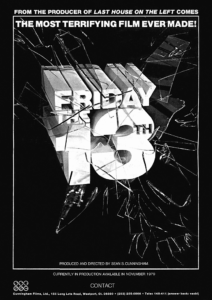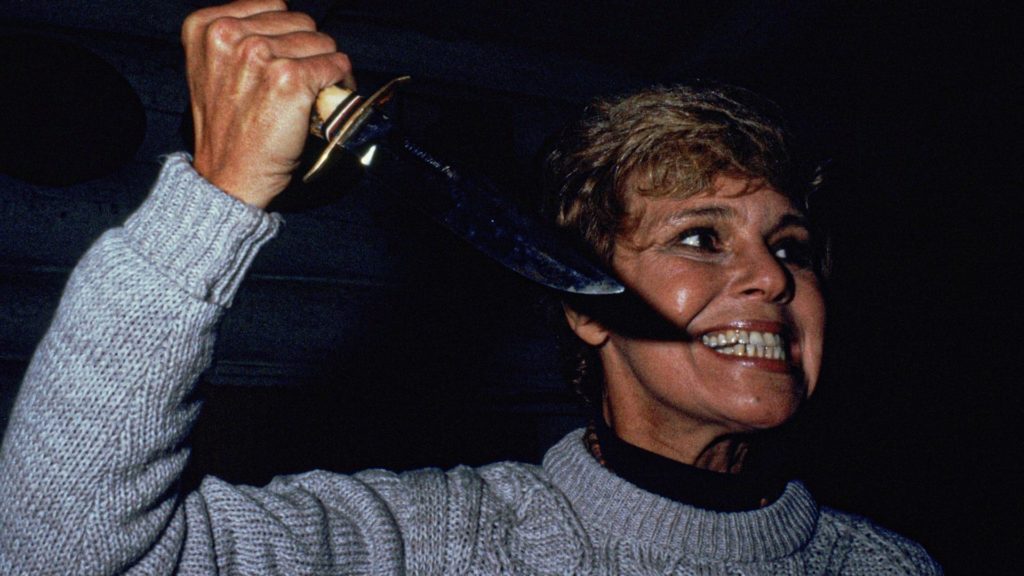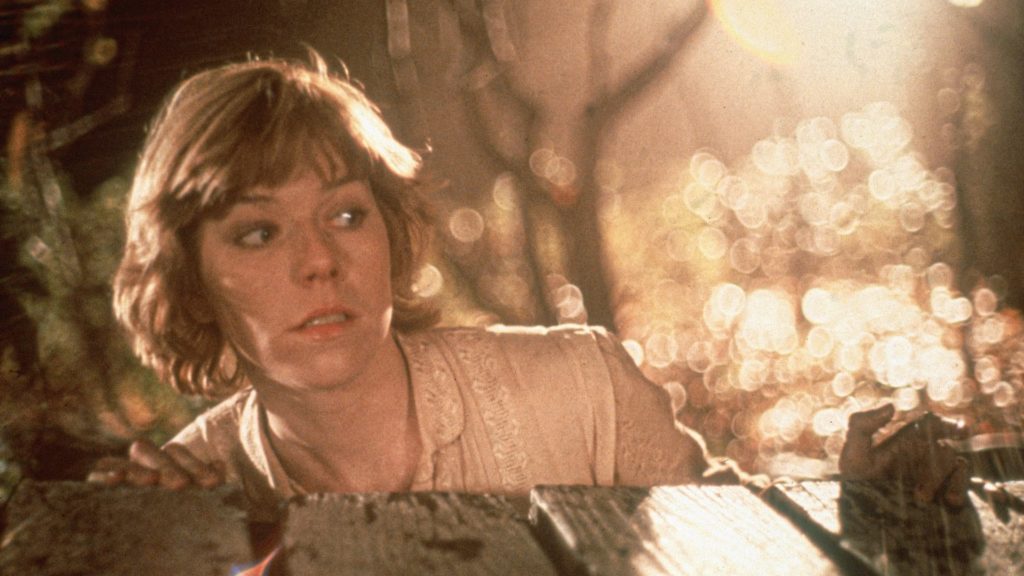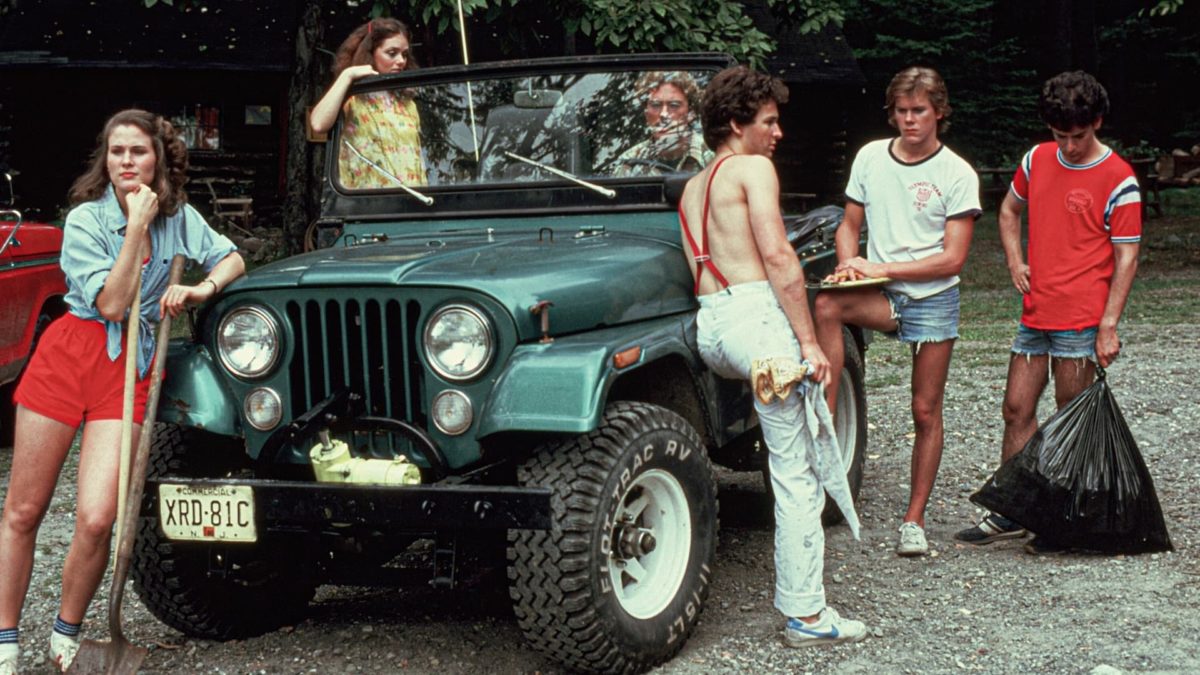You're doomed! You're all doomed!
I find the origin story of Friday the 13th to be poetic. Not the story in the film itself, not in the slightest; I mean the origin story of the production. Producer-director Sean S. Cunningham, a collaborator of John Carpenter, wanted to make his own knockoff Halloween, but injected with pulpy, roller-coaster steroids. He paired with screenwriter Victor Miller and came up with a draft for a movie titled A Long Night at Camp Blood.
Then a lightning bolt of inspiration hit him: Title the film Friday the 13th. The title had no relationship with Miller’s screenplay draft, but Cunningham saw dollar-signs in the elegant, memorable title. He was certainly right. It’s hard to imagine eleven sequels to a film called A Long Night at Camp Blood.
Despite a half-formed concept and script, let alone a crew or cast or a second of footage, Cunningham wanted to plant his flag on the Friday the 13th hill and brand without delay. He placed an ad for the movie in Variety magazine on July 4, 1979, nearly a year before the movie would eventually debut, proclaiming his upcoming movie “the most terrifying film ever made!”

Thus, Friday the 13th was born… with an advertisement. Not with an unmissable narrative idea; not with reinvention of familiar tropes; not with an unstoppable creative vision, but with a public promise of spectacle to anyone willing to fork over money for a movie ticket. Friday the 13th is the only one of the four major slasher franchises (this, Halloween, Texas Chainsaw Massacre, and Nightmare on Elm Street) not to debut with a major artistic statement. In fact, Friday the 13th is a lazy nothing of a movie, but oh-so-watchable as popcorn fun.
As part of his shoestring crew (the budget barely cracking a half million dollars), Cunningham recruited gore effects designer Tom Savini of Dawn of the Dead fame and composer Harry Manfredini. Savini’s touch would give Friday the 13th its claim to fame and signature brand: groundbreaking, baroquely amusing gore effects. Manfredini, meanwhile, would be the series biggest stalwart, scoring 8 of 11 sequels.
Friday the 13th has the most bare-bones of plot. It’s more premise than story. A bunch of attractive young adults, all presumably around the age of 18, get hired to work at Camp Crystal Lake that has been shut down for decades following a brutal murder 22 years ago. While they wait for the camp to start, they goof around and canoodle, only to get murdered by an unseen assailant one-by-one until the only survivor is Alice (Adrienne King). Alice discovers the murderer to be… Pamela Voorhees (Betsy Palmer), the mother of a boy named Jason Voorhees who drowned at the camp years ago. Pamela blames inattentive counselors for her son’s death, and takes out her vengeance on everyone associated with the camp decades later. In a reverse-Psycho, she channels her son as she commits these violent murders.

Alice ultimately survives, decapitating Ms. Voorhees with a machete. Then, with the ordeal presumably finished, the previously-unseen corpse of Jason inexplicably jumps out of the lake to try and drown Alice as a final jump scare. Alice abruptly wakes up in the hospital where the authorities assure her there was no zombie corpse in the water. Was that last scare a stress dream, or did the supernatural encounter really happen?
On about 95% of the metrics one would evaluate Friday the 13th, it is a pretty bad movie, but that 5% matters so much.
Let’s start with the bad, though: The script is a bunch of filler nonsense, teen chatter peppered with spooky-mongering. I wouldn’t be surprised if major parts of the script were improvised, with Cunningham essentially saying “just banter like horny teens.”
The only thing remotely resembling narrative thrust or shape is the “mystery” aspect of the killing spree, in which the audience isn’t shown the identity of the stabber. If you squint a little bit, the screenplay has the approximate structure of a whodunit, but the faint gestures towards a mystery story do not stand up to any scrutiny. For one, there’s never any opportunity for anyone to try and deduce the culprit: everyone is killed the instant they realize there’s a murderer on the loose (everyone except Alice). The audience is shown no evidence or clues or suspects. The revelation of the culprit offers no flicker of recognition; Jason’s drowning was barely mentioned at the film’s opening.

The acting is no more refined than the story. Kevin Bacon is the only famous face here. He plays a beefcake jock, but he doesn’t stand out, and none of the other names here are of note or talent. King is barely adequate as the free-spirited “final girl” Alice, struggling to deliver every one of her lines in a believable cadence. Palmer is memorable as the villain, but not exactly good, hamming Mrs. Voorhees up to eleven.
One strength is the on-location shooting that feels like summer. Some of the footage of the lake and surrounding nature you might even call lovely. On the other hand, plenty more of the footage you would call bland, especially the completely illegible nighttime photography: A significant number of shots are all black with blurry, barely visible objects as the ostensible focus, no sense of space or even sufficient contrast to tell what we’re looking at.
Manfredini’s score has become iconic, but I think it’s a Stockholm syndrome situation. The theme is an unremarkable piece that sounds like a cheap Psycho knockoff with some thumping percussion thrown in. But once a piece of music appears in a dozen movies, I think it automatically qualifies as a classic to many people.
Perhaps most crippling of all the flaws is that there’s almost no suspense. This is not a scary movie. It cribs cinematic language from Halloween like long tracking shots and POV angles suggesting a looming threat, but it does so without actually generating tension. (It’s ironic, given the “most terrifying movie ever made” tagline from the original Variety ad.)
I do wonder if the lack of suspenseful content made the film more approachable, though. Many of the most artistically uncompromising slashers are absolutely brutal to sit through, filled with anxiety-inducing dread and nihilism. Friday the 13th inadvertently turns its weakness of no gut-wrenching scares or dread into a strength, giving off the breezy air of a thrill ride at a summer carnival rather than a descent to grim bleakness.
For all this series is known for gratuitous sex and violence, this first Friday the 13th is light on the former: It’s true that there’s nonstop suggestion of sex; it’s constantly in the air. But there’s only one brief scene with actual depicted intercourse, barely a flash of nudity. So it’s not like this is attempting to be sleazy exploitation fun.

That sums up the 95% that doesn’t work. So what is the 5% of Friday the 13th that actually works? For starters, Savini’s gore. In retrospect, it feels a bit quaint; just one or two years later, slashers would be filled with inventive and bloody kill scenes putting everything here to shame. Cunningham and Savini offer some slit throats, a couple impaled bodies, one decapitation. But Friday the 13th is still visceral and shocking relative to the Hollywood norm (and even today might be a bit much for anyone not desensitized to violent horror). It served as a minor revolution in the American horror cinema industry by normalizing on-screen violence and blood as part of teen entertainment.
The film also has an ineffable likability about it, particularly the easygoing teens. Friday the 13th balances the wish fulfillment of being attractive and liberated and hanging out with the same vs. the terror of stalking danger. (No wonder cultural analysts have a field day theorizing on the psychosexual undercurrents of the slasher subgenre; it’s hardly even subtext.)
Friday the 13th’s real accomplishment and innovation is taking the basic structure of Halloween and tweaking it just enough to make it into easily-replicated formula. Halloween was the perfectly-designed prototype; Friday the 13th is the mass-production model that lacks the grace of the original but suggests a profitable path forward.
The format is such: Introduce a bunch of forgettable characters who will be brutally killed (and one young woman who won’t be killed); follow a murderer who takes down one person or couple every 10-15 minutes of rising tension; each gnarly, bloody kill becomes a bit of spectacle offering catharsis on the rising tension; climax with the murderer chasing down the “final girl,” only to be done in at the last minute; and just when peace is restored, end with one last peek-a-boo jump scare. It’s such an elegant formula, so ripe for repetition, innovation, and eventually parody.

In fact, the least streamlined part of Friday the 13th is the most ambitious: the “twist” villain of a grieving/possessed mother. It throws a wrench in the low-friction design of the rest of the film. It’s an honest-to-God “idea.” It’s no surprise to me that the rest of the franchise ditched the Mommie-dearest concept and cast a hulking, mask-wearing psycho as its villain.
I cannot in good conscience say that Friday the 13th is a “good” thriller, but I must admit I enjoyed myself and felt like I had discovered a key turning point in the commodification of horror movies. The historical importance of the film (and, frankly, my excitement at watching this level of trashy pleasure for another 11 movies) has me rating this grubby little flick one tick higher than I probably would otherwise.
For further reading, I highly recommend slasher enthusiast Brennan Klein’s review of the film (and his entire Census Bloodbath series for that matter). His enthusiasm is infectious; I especially love his investigation into some of Alice’s dumb-dumb decision-making.
- Review Series: Friday the 13th
Is It Good?
Nearly Good (4/8)
Dan is the founder and head critic of The Goods. Follow Dan on Letterboxd. Join the Discord for updates and discussion.


3 replies on “Friday the 13th (1980)”
I like Friday the 13th ’80, though as I like the series a lot more than most, I don’t know if it means anything that it’s still my second or third least-favorite of the Paramount eight. (I think it means a little: I’d argue it’s the most ineptly-made on pretty much an objective level, including 3’s 3-D shenaniganry, which I clearly enjoy much more than I ought to, and 5, which is maybe slightly bad. Though the only one I really don’t like is 8.)
It’s a pity the franchise peaks so early with 2, though, 2’s kinda great.
I was disappointed to see the eighth was the only one reviewed on Kinemalogue (and worried it meant you were out on the entire franchise, glad to see you’re not)… but at least we have Brennan’s blog!
Oh yeah, I strongly considered doing them this year, but you got the jump on me–and, that’s for the best, I’ve pretty much already committed to finishing the AIP Gothic horror series I started two damn years ago, and then ordering a small stack of horror-adjacent movies about spiritualism because I guess I really am that easily pushed around by Kenneth Branagh.